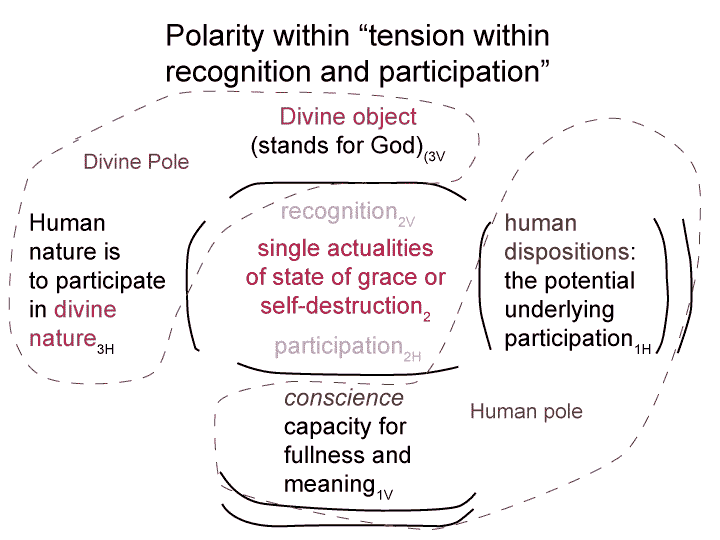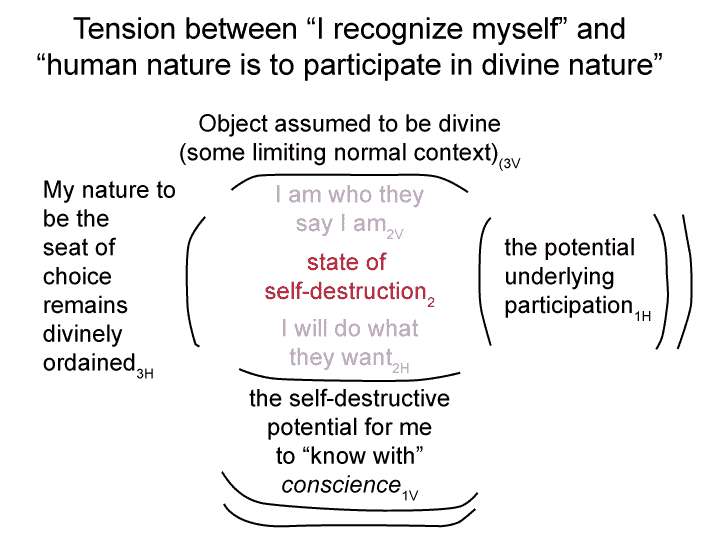Man and Sin by Piet Schoonenberg (1964) 2.1DU
Summary of text [comment] page 69
Schoonenberg used the word ‘counterpole’ to describe the difference between the source and the subject of grace.
[By ‘counterpole’ Schoonenberg alluded to divine and human poles.
The intersection, modeling the tension within recognition and participation, carries a polarity with divine and human poles.]
Man and Sin by Piet Schoonenberg (1964) 2.1DT
[The realm of actuality obeys the laws of noncontradiction.
Noncontradiction is different than the exclusivity of the normal context.
The laws of noncontradiction set the stage for the exclusivity of the normal context.
Our own experiences of ‘grace’ and ‘self-destruction’ confirm this.
The single actuality of ‘grace’ and ‘self-destruction’ encompasses two contending actualities, participation and recognition, which always seem to be contradicting one another. Yet, they belong to the same actuality.
We experience a battle among contending forces. We wonder whether one or the other will gain an the upper hand.
Which dominates?
A state of grace or a state of self-destruction?]
Man and Sin by Piet Schoonenberg (1964) 2.1DS-2
[Detachment initiates the transition from 2-level interscope to intersection.
Detachment initiates the transition from sensible to social construction.]
Man and Sin by Piet Schoonenberg (1964) 2.1DS-1
[What lessons come from these associations?
First, two interscoping forms may coalesce into an intersection. The intersection gels when the perspective level no longer supports sensible construction.
Sensible construction is depicted by a two level interscope, containing only content and situation. The perspective level is assumed to be valid and appropriate.
In the interscoping forms, ‘the potential underlying participation1b’ emerges from and situates ‘my recognition2a’. ‘My recognition2a’ comes from ‘the potentials of me to recognize myself1a’.
These elements are not in tension when the perspective level is taken for granted.
When the perspective level no longer ‘makes sense’, the actualities of recognition and participation also no longer make sense. The actualities of recognition and participation are in tension.
The tension between ‘I recognize myself’ and ‘my human nature is to participate in the divine nature’ produces an intersection at the moment when ‘my self-recognition2a’ no longer sensibly undergirds ‘my potential for participation1b’.]
Man and Sin by Piet Schoonenberg (1964) 2.1DR
[The prior blog on the symbolic features of words will now be brought to bear on the two versions of the single actuality belonging to the intersection of recognition and participation.
One actuality may be labeled ‘grace’ (Figure 2.1 DL).
The other actuality may be labeled ‘self-destruction’ (Figure 2.1 DN).
The single actuality is ‘either grace or self-destruction’.
These two words contrast with one another in a system of differences.
Both these actualities emerge from and situate two potentials.
The potential underlying recognition derives from ‘the omnipotence of God’ (for grace) or ‘the limited potencies of my own self-recognition’ (for self-destruction).
The potential underlying participation derives from ‘the omniscence and omnipresence of God’ (for grace) or ‘the limiting choices afforded me by my normal context’ (for self-destruction).]
Man and Sin by Piet Schoonenberg (1964) 2.1DQ
[As soon as someone comes up with a difference, the spell should be broken. The adjective ‘social’ will then resume a place within a system of differences.
Then this shoe of Progressivism slips off.
So what is this hidden term that contrasts with ‘social’?
The term ‘sensible’ contrasts with the word ‘social’.
The words ‘social’ and ‘sensible’ produce two contrasting and exclusive primordial images.
‘Social justice’ is a different primordial image than ‘sensible justice’.
‘Social’-isms are different primordial images than ‘sensible’-isms.]
Man and Sin by Piet Schoonenberg (1964) 2.1DP
[For example, consider the term ‘social’. Progressives use this term as a qualifier (in terms like ‘social justice’, ‘social equality’, ‘social responsibility’ ‘social construction’, in sum, all ‘social’-isms).
The qualifier ‘social’ does not have a contrasting qualifier.
The contrasting qualifier is hidden.
Why is it hidden?
If the word ‘social’ points to a particular normal context, then this normal context cannot be questioned. Otherwise, the contrasting qualifier would not be hidden.
The hidden normal context must be assumed.
Normal contexts obey the laws of exclusivity. In this instance, ‘any contrasting qualifier’ must be excluded. The word ‘social’ is a point de caption. It is like the knot in a shoelace holding the shoe onto the foot. If it comes undone, the shoe falls off.
What?
If you do not bend knee to ‘social justice’, then what kind of monster are you?
The word ‘social’ is a clue. It tells whether the conversant is thinkpro-object or thinkanti-object.]
Man and Sin by Piet Schoonenberg (1964) 2.1DO
Summary of text [comment] page 69
[Words belong to systems of differences.
Whenever hearing a word, the listener should ask:
What is this word different than?
If the word has no contrasting terms, then the word veils a contrast.
Furthermore, the veiled contrasting term must remain hidden.]


